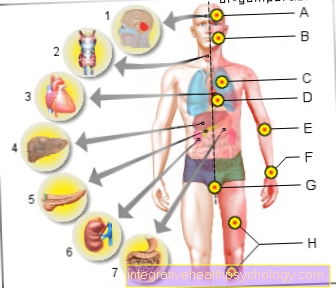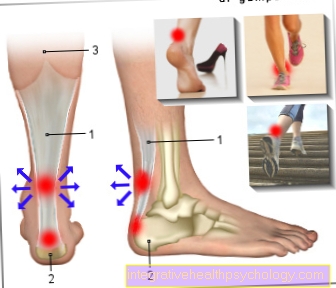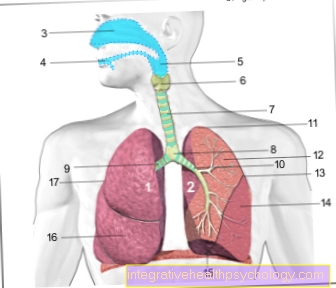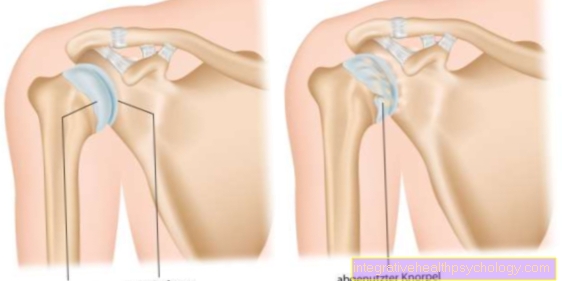Trichomonads infection
What is a trichomonas infection?
Infection with trichomonads, also known as trichomoniasis, is one of the most common sexually transmitted diseases (STDs). This is a parasitic infection, especially in women.
Even if the infection is asymptomatic in most cases, typical symptoms can occur, such as an unpleasant green-yellowish discharge.
The suspicion of an infection can be assumed based on the patient's anamnesis and confirmed by special tests.
The therapy is carried out with an antibiotic, whereby the partner should always be treated.
Learn more about STDs.

Causes of Trichomoniasis
Trichomoniasis is the most common sexually transmitted disease (STD = sexually transmitted diseas) worldwide, with 170 million people affected each year. It is relatively rare in Germany, and patients in Germany are often infected by foreign sex partners on vacation.
The pathogen is a pear-shaped protozoa named Trichomonas vaginalis. It is a parasite that can survive mainly in semen or vaginal secretions. Accordingly, there is direct transmission from one partner to the other during sexual intercourse. Often, however, it is not solely responsible for the infection, but leads to a so-called mixed infection with other bacteria.
In very rare cases, indirect transmission can also occur, for example when bathing in a swimming pool or on the toilet. Since in most cases the infection runs without symptoms for months to years, those affected often do not know that they are sick and unknowingly pass the parasites on if they have unprotected sexual intercourse. Often changing sex partners increase the risk of infection.
Transmission path
In most cases, transmission takes place directly from host to host during unprotected sexual intercourse. Since the parasite lives in the sperm or vaginal mucus, it can switch from one partner to the other through these fluids.
The acidic and moist environment in the vagina provides a good living space for the parasite, while outside of the body it cannot survive for long. The parasite can then stay in the female genital organs via the vagina, but it preferably remains in the vagina. In men, it nests in most cases in the urethra, prostate or penile foreskin.
diagnosis
The anamnesis plays the most important role in making the diagnosis. If the patient speaks of frequently changing sex partners or green-yellowish discharge after sexual intercourse abroad or with a foreign partner, the doctor can usually suspect a sexually transmitted disease. Because trichomoniasis is a common STD and the discharge is typical, this infection is quickly considered.
To confirm the diagnosis, a swab of the vaginal wall in women or the urethra in men can be taken, which is examined under the microscope. This then shows a so-called flagellate with flagellates. This ensures the diagnosis. Nonetheless, other sexually transmitted diseases such as chlamydia, syphilis, and gonorrhea should be excluded.
incubation period
It can take anywhere from 5 days to 3 weeks from infection to onset of symptoms. In most cases (approx. 80%), however, there are no symptoms and the parasite can survive in the host for months to years. In men in particular, the course is usually asymptomatic.
These symptoms can be used to recognize a trichomonas infection
In men, the infection proceeds without symptoms in most cases. In very rare cases, inflammation can occur in the areas where the trichomonads have established themselves, i.e. in the prostate or urethra area, which can be accompanied by painful urination and itching.
In women, the infection usually leads to inflammation of the vaginal wall (Vaginitis) with a point-like reddening typical of the disease. One then speaks of a so-called “strawberry cervix”, which, however, can only be discovered by an examination by the gynecologist. The inflammation can lead to painful urination, burning sensation, and itching. You may also experience pain during intercourse. Also typical of the infection is a foul-smelling, green-yellowish discharge (fluorine) from the vagina, which strongly resembles the smell of rotten fish. If the inflammation continues upwards, it can also affect the uterus or fallopian tubes. In rare cases, infertility can also prevail during the infection.
Treatment / therapy
Treatment of an infection caused by trichomonads is primarily carried out using antibiotic therapy. The antibiotic of choice here is metronidazole, which is usually administered orally twice a day for 7-10 days or, in the case of severe infections, systemically, i.e. via the blood. The dosage requires the expert decision of a doctor.
It is also important to treat the partner as well, even if he does not show any symptoms. As described above, an infection can often be asymptomatic. However, the parasite can survive unnoticed in the body for months to years and renewed sexual contact can lead to further transmission and infection. One speaks of the so-called ping-pong effect, which has to be prevented. Sexual intercourse should be avoided during treatment.
After a week, i.e. after the end of the therapy, a control smear can be carried out to ensure that there are no more trichomonads living in the genital area.
Over-the-counter drugs
Metronidazole as an oral antibiotic cannot be obtained without a prescription in Germany, but requires the doctor to issue a prescription. This is due to the numerous side effects and the fight against resistance through the use of antibiotics.
However, there are few drugs that contain the active ingredient in small amounts. These are drugs that can be used in women in the form of an ointment or a vaginal suppository for local application in the vagina. A distinction is made between the drugs Eubiolac Verla, a vaginal suppository with the active ingredient “lactic acid”, and Evazol and Fluomizin, a cream or a suppository with the active ingredient “Dequalinium”.
However, they cannot replace intensive antibiotic therapy with metronidazole. A doctor or pharmacist should be consulted before taking such preparations.
What is the best antibiotic?
The antibiotic of choice for trichominiasis is metronidazole, an antibiotic from the group of nitroimidazoles. It is mainly used in anaerobic bacteria and protozoa. It leads to DNA breaks in the pathogen's genes.
In trichomoniasis, it is usually used orally for 7-10 days with a dosage of 400mg twice a day. Alternatively, you can also take 2g once a day. However, the decision on the correct dosage rests with the attending physician.
Metronidazole has a good success rate in treating trichomonas infection. Like all antibiotics, however, it leads to some side effects, such as: diarrhea, headache, itching. However, these are usually rare.
Long term consequences
The prognosis of a trichomonas infection is usually very good. Antibiotic treatment is successful in most cases; only in rare cases are the check-ups still positive, so that the therapy has to be carried out over a longer period of time. However, there is no immunity after infection, which means you can be infected again several times.
Complications of trichomonas infection are, although rare, an ascending infection of the upper genital organs. An inflammation occurring there can lead to adhesions in the area of the fallopian tubes and thus to infertility. In addition, trichomoniasis can promote infection with other bacteria or fungi. During pregnancy, infection can be transmitted to the newborn and have serious consequences.
In men, the infection can spread to surrounding organs and lead, for example, to inflammation of the prostate or epididymis.
However, the risk of chronic infection or infertility is very rare and usually only occurs with long-term non-treatment.
Trichomonads infection in pregnancy
Infection with trichomonads during pregnancy is not without risk.
For one thing, infection can increase the risk of premature birth, premature rupture of the bladder, and low birth weight. This can have far-reaching consequences for the child's life.
On the other hand, the parasite can be transmitted to the newborn at birth and cause inflammation in the child. Especially in female children, it often leads to inflammation in the vagina area.
Oral administration of metronidazole during pregnancy is contraindicated in the first trimester. You therefore tend to limit yourself to local treatment or switch to another antibiotic, such as clotrimazole or amoxicillin. From the 2nd trimester, however, oral therapy is harmless, so that normal oral antibiotic therapy should be continued for 7 days.
















.jpg)












